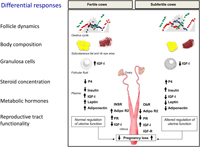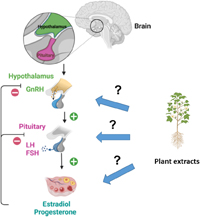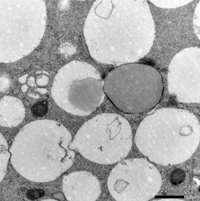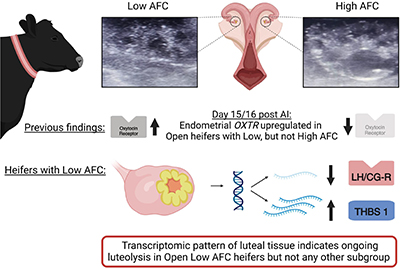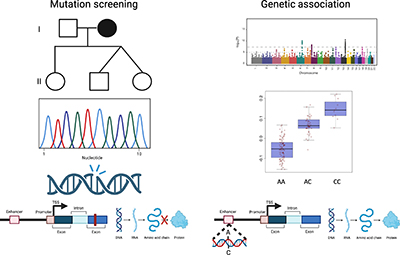The biology of the ovary – Honouring the contributions of Ken P McNatty and Rex J Scaramuzzi
For blood cancer survivors, a fertility preservation treatment generating eggs in culture by using their own cryopreserved ovarian tissue does not yet exist. This could be due to culture media missing crucial factors that exist in the circulation. We showed that mouse ovarian follicles do indeed grow better in culture supplemented with mouse serum. By identifying that there are additional factors in mouse serum that improve mouse ovarian follicle development, this paves the way to identify these molecules, which would likely be informative for humans. Image by Sabriya Abdul Kader.
This article belongs to the collection: The biology of the ovary – Honouring the contributions of Ken P McNatty and Rex J Scaramuzzi.
Infertility in women has been associated with increased ovarian fibrosis with age, and failure to ovulate an egg in conditions such as polycystic ovarian disease. Fibrosis can be increased by certain growth factors, such as the CCN proteins, which may also be involved in inflammatory processes leading to ovulation. This review summarized the known effects of CCN proteins in ovarian function, and proposes a role in ovulation. Image made in BioRender.
This article belongs to the collection: The biology of the ovary – Honouring the contributions of Ken P McNatty and Rex J Scaramuzzi.
The food animals eat has a major influence on their ability to reproduce. This experiment was designed to determine if fatness or high-energy diets affected the socio-sexual responses of ewes to rams. High-energy diets stimulated insulin and glucose but had little influence on reproductive responses. Thin ewes had reduced glucose and insulin and compromised responses to socio-sexual stimulation, suggesting that fatness was a significant contributor to reproductive success.
Textbooks, websites and YouTube videos present misinformation about the ovary with statements and illustrations that are patently inaccurate or incorrect. Even multiple edition textbooks still have major misleading inaccuracies occurring in text and illustrations. Amongst other inaccuracies many report that the prepubertal human ovary is dormant and that a human primordial follicle grows into preovulatory follicles during the course of the follicular phase of 14 days. How did we get here and more importantly how can it be rectified? Diagram byProfessor Jeffrey B. Kerr.
This article belongs to the collection: The biology of the ovary – Honouring the contributions of Ken P McNatty and Rex J Scaramuzzi.
Subfertile cows that get pregnant late in the breeding season are less productive. We found that fertile cows had more fat and muscle, greater circulating concentrations of metabolic hormones, healthy follicles with more granulosa cells and higher insulin-like growth factor 1 in the follicular fluid. Fertile cows had fewer circulating concentrations of progesterone but the sensitivity of the endometrium to progesterone and adiponectin was greater than in subfertile cows. Fertility was associated to the cow metabolism, that regulates uterine function to reduce embryo losses. Diagram adapted from Meikle et al. (2018).
This article belongs to the collection: The biology of the ovary – Honouring the contributions of Ken P McNatty and Rex J Scaramuzzi.
A very small proportion of eggs in the ovaries are ever ovulated but it is not known how the ovary chooses which eggs ovulate. We discuss the evidence that high-quality eggs produce signals that increase their rate of maturation allowing them to win the race to ovulate. If the ovary can detect which eggs are good quality, then it might be possible to adapt this to improve treatment in fertility clinics. Image by Michael Pankhurst.
This article belongs to the collection: The biology of the ovary – Honouring the contributions of Ken P McNatty and Rex J Scaramuzzi.
It has long been known that the amount and type of food can influence fertility, but exactly how is unknown. In this study, we asked whether common sugars were used differently by ovarian cells and found that theca cells use glucose and galactose, but not fructose, because they lack a fructose transporter. This study supports the theory that the amount and type of dietary sugar can affect ovarian function, and hence fertility.
Plant extracts can be an alternative to treat some female infertility. Female fertility is a complex process regulated by hypothalamic–pituitary-ovarian unit involving both negative and positive feedback mechanisms. Because this hypothalamo–pituitary-ovarian axis is crucial in the regulation of female fertility, this review highlights mechanisms of action of various plant extracts on this axis. Diagram by J. Dupont using BioRender software.
This article belongs to the collection: The biology of the ovary – Honouring the contributions of Ken P McNatty and Rex J Scaramuzzi.
Poor egg (oocyte) quality is a leading cause of reduced fertility in humans and animals. Large vesicles within oocytes appear to be important for oocyte quality in animals but their composition is unknown. Our study has identified that these vesicles, which appear empty in electron micrographs, contain lipid that differs to that contained in classical lipid droplets. This knowledge may be used to improve in vitro maturation media to enhance oocyte quality. Image by K L Reader.
This article belongs to the collection: The biology of the ovary – Honouring the contributions of Ken P McNatty and Rex J Scaramuzzi.
Livestock production systems rely on efficient reproduction. Selection of heifers with a high number of antral ovarian follicles can be applied with the aim of improving reproductive efficiency. The herein presented results support an earlier onset of luteolysis in non-pregnant heifers with a low number of antral follicles. This indicates a shorter time period for the recognition of pregnancy by the dam, which might contribute to inferior reproductive performance in heifers with a low number of antral ovarian follicles. Image by MK, created with biorender.com.
This article belongs to the collection: The biology of the ovary – Honouring the contributions of Ken P McNatty and Rex J Scaramuzzi.
Regulated growth and development of ovarian follicles are important for fertility, and locally produced factors are key regulators of these processes. We investigated whether locally produced platelet derived growth factors (PDGF) play an important role in the growth and function of ovine follicles. Multiple PDGF ligands, as well as their receptors, were expressed in developing follicles, and PDGFBB altered key follicular functions, indicating these growth factors are important for the regulation of growth and development of ovarian follicles in sheep. Image by Jennifer Juengel.
This article belongs to the collection: The biology of the ovary – Honouring the contributions of Ken P McNatty and Rex J Scaramuzzi.
The number of oocytes retrieved during assisted reproduction is a key determinant of success in both cattle and humans. Ovarian follicular flushing is not practised in cattle but offers the prospect of increasing oocyte yield and number of transferrable embryos. We determined that a ‘hybrid’ approach of flushing larger follicles and aspirating smaller follicles has potential in this regard. These findings serve as an impetus for follow-up studies in human and equine assisted reproduction. Image provided by authors.
This article belongs to the collection: The biology of the ovary – Honouring the contributions of Ken P McNatty and Rex J Scaramuzzi.
Genetic studies have discovered multiple mutations and genetic risk factors that have helped to understand how ovulation rate is controlled in low ovulating species to regulate the numbers of offspring and maximise reproductive success. Most genes identified are from pathways with defined roles in regulation of the ovarian follicle development. Continued genetic studies can continue to improve detailed understanding of the regulation of ovulation rate and litter size with implications for health and animal production systems. Image by G. W. Montgomery.
This article belongs to the Collection The biology of the ovary – Honouring the contributions of Ken P McNatty and Rex J Scaramuzzi.






